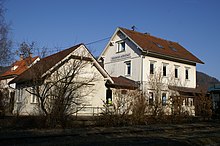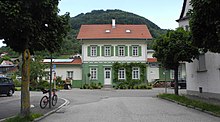Geislingen (Steige) –Wiesensteig railway line
| Geislingen (Steige) –Wiesensteig | |||||||||||||||||||||||||||||||||||||||||||||||||||||||||||||||||||||||||
|---|---|---|---|---|---|---|---|---|---|---|---|---|---|---|---|---|---|---|---|---|---|---|---|---|---|---|---|---|---|---|---|---|---|---|---|---|---|---|---|---|---|---|---|---|---|---|---|---|---|---|---|---|---|---|---|---|---|---|---|---|---|---|---|---|---|---|---|---|---|---|---|---|---|
|
Geislingen train station
| |||||||||||||||||||||||||||||||||||||||||||||||||||||||||||||||||||||||||
| Route number (DB) : | 4740 (Geislingen (Steige) –Wiesensteig) 4741 (Abzw Helfenstein – Eybtal) 4742 (Geislingen (Steige) West – Eybtal) 4743 (Eybtal – Geislingen (Steige)) |
||||||||||||||||||||||||||||||||||||||||||||||||||||||||||||||||||||||||
| Course book section (DB) : | 904 | ||||||||||||||||||||||||||||||||||||||||||||||||||||||||||||||||||||||||
| Route length: | 21.26 km | ||||||||||||||||||||||||||||||||||||||||||||||||||||||||||||||||||||||||
| Gauge : | 1435 mm ( standard gauge ) | ||||||||||||||||||||||||||||||||||||||||||||||||||||||||||||||||||||||||
| Maximum slope : | 1:37 = 27 ‰ | ||||||||||||||||||||||||||||||||||||||||||||||||||||||||||||||||||||||||
| Minimum radius : | 200 m | ||||||||||||||||||||||||||||||||||||||||||||||||||||||||||||||||||||||||
|
|||||||||||||||||||||||||||||||||||||||||||||||||||||||||||||||||||||||||
The Geislingen (Steige) –Wiesensteig railway line , also known as the Tälesbahn or the vernacular Täleskätter , was a 21.26-kilometer standard-gauge branch line in the Upper Filstal in Baden-Württemberg .
history
The branch line from Geislingen an der Steige to Wiesensteig was inaugurated on October 21, 1903. In the early years, the valley railway was primarily used to transport people and goods for companies located in the region. The Geislingen an der Steige – Stauferstolln section was electrified on December 12, 1937 due to the heavy ore trains. In the Third Reich, iron ore was increasingly mined for weapons production under the Geislinger Michelsberg and transported from this mine with the valley railway to Geislingen station, from 1940 to 1944 via a turning station in the Eybtal , and on to the iron and steel works in the Ruhr area . The Eybtal Kehrbahnhof was opened on October 6, 1940 in order to be able to drive ore trains from the so-called Staufenstolln to the Filstalbahn, bypassing the Geislinger Bahnhof, but was no longer needed from September 1944 and remained in use as a storage facility until December 1947. Its access tracks were dismantled by November 1948.
Shutdown
After the mine was closed in 1963, the removal of the ore that was still on the dump was completed three years later. Passenger and freight traffic was discontinued on the Deggingen – Wiesensteig section in 1968 and the tracks were dismantled. As far as Deggingen, passenger traffic was maintained until June 1, 1980, freight traffic until September 29, 1981. The tracks were removed from Deggingen to the locomotive shed at the mine station by February 1982. On the remainder of the stretch from Geislingen main station to near the city limits, goods traffic for two companies took place until January 1, 2001. On the occasion of the 150th anniversary of the Geislinger Steige , special trips were possible in the summer of 2000 with the local train of the Ulm Railway Friends from Amstetten via the Geislingen (Steige) station to Geislingen-Altenstadt. In December of the same year, rail traffic was finally stopped and the line completely shut down.
Relics
In the through-town of Bad Überkingen, the route is built over, after which there is a bicycle path to Wiesensteig. To the right and left of the route you can also find some witnesses of the railway era, including milestones, signal foundations or remains of platform edges.
As far as Geislingen Altenstadt, the route and the railway locations are still clearly recognizable and partially preserved, after which there is little reminiscent of the railway.
- The embankment is still up until shortly before the former mining station, in the station it has been partially removed. The station also had an engine shed, which is still preserved.
- The Bad Überkingen train station no longer exists; Mineralbrunnen AG now stands in its place and on the former route . Only the Bahnhofstrasse and the house number 15, which today belonged to Mineralbrunnen AG and which used to be the train station, still remember him. Shortly after Bad Überkingen is the foundation of the entry signal for Bad Überkingen train station. .
- Only one restaurant remains from the Hausen an der Fils stop, which used to belong to the stop. Nothing can be seen of the station building, it was torn down. In the place of the station building there are now residential houses, the street at the old train station was built on the former route.
- The Reichenbach im Täle stop has remained almost unchanged. The station house, the route and the platform edge have been preserved. Today the building is used by the railway social work as a hiking home, the former platform as a property delimitation and garden area to the route.
- The Deggingen train station and the route in the Deggingen area are still preserved, the station building has meanwhile been renovated (after it had fallen into disrepair for many years). The station building of the Bad Ditzenbach train station is no longer standing, it was the victim of a fire drill. Today there are partly residential buildings and the federal highway 465 on the former route.
- Nothing can be seen from the Gosbach train station or the route. This building also disappeared during a fire drill.
- The abutments of the former bridge over the Hollbach still exist between Gosbach and Mühlhausen-Gruibingen.
- There is also nothing to be seen of the Mühlhausen-Gruibingen train station; it was also the victim of a fire drill. On the site of the former train station, there is now an industrial area, and here, too, nothing reminds of the train station.
- Only the former station kiosk remains from the Wiesensteig terminus. Like the other train stations, this building was also the victim of a fire drill. Where the reception building and the tracks used to be, there are now some parking spaces, buildings and Bahnhofstrasse.
Failed restart
The aim was to reactivate the remaining 4.45 kilometers long section for freight and tourist traffic. The city of Geislingen therefore bought the remaining section of the route from Deutsche Bahn in 2004; because it is completely in the area of the city of Geislingen. In the meantime, an interest group had also been founded and began to renovate the track systems. In addition, several rail construction vehicles were bought in order to be able to put the line back into operation independently. The concept provided for goods traffic to be carried out again in the area of the city of Geislingen. In addition, tourist trains and special trips across the route should possibly be carried out later. The main source of income, however, should be freight transport. The concept failed due to a lack of interest from the neighboring companies and financial support from the city of Geislingen. Nobody wanted (or could) have transports carried out by rail. Not even WMF, which had its main plant directly on the route with a siding, extensive track systems in the plant and its own plant locomotive. WMF was also the last freight customer of the valley railway, and until it was closed in 2000, it still regularly received wagons with steel for the manufacture of their products. Recommissioning initially only for tourist traffic failed due to the high costs and the lack of the possibility of reactivating the route for local passenger traffic in full at some point. A reactivation from Geislingen would only have been possible as far as the former mining station. After the interest group failed to find freight customers for the reactivated route, the Geislingen municipal council decided in March 2011 to convert the route into a cycle path. For this purpose, the route was de-dedicated in March 2012, and a few meters of track at the level of the entry signal to Geislingen station was expanded. At the same time, a buffer stop was built so that the remaining section could then be officially de-dedicated.
literature
- Peter-Michael Mihailescu, Matthias Michalke: Forgotten railways in Baden-Württemberg . Konrad Theiss Verlag, Stuttgart 1985, ISBN 3-8062-0413-6 , p. 219-222 .
- Rudolf P. Pavel: Geislinger Steige and Täleskätter - Württemberg Railway History , Pavel, Neckargerach [approx. 1982]
Web links
- Information on the history and the current status of the Tälesbahn: IG Tälesbahn Geislingen e. V.
- Location and course (incomplete) of the route on the OpenRailwayMap
- Forgotten railways: Geislingen (Steige) –Wiesensteig (photo documentation of the condition in March / April 2007)
- The valley railway at www.esslinger.de
Individual evidence
- ↑ return station Eybtal. on: vergierter-bahnen.de
- ^ Out for the valley railway ( memento from April 2, 2011 in the Internet Archive ), Geislinger Zeitung from March 31, 2011
- ↑ Cycling on the valley railway ( memento from September 24, 2015 in the Internet Archive ), Geislinger Zeitung from November 25, 2011


